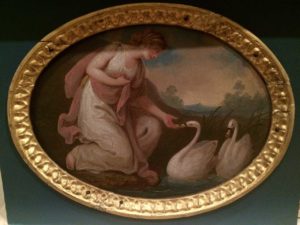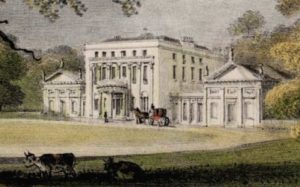Channeling Kauffman: A Chimneypiece at the Philadelphia Museum of Art
EMERGING SCHOLARS > SUMMER RESEARCH GRANTS
Rachel Harmeyer,
PhD Candidate, Department of Art History, Rice University
A Summer Travel Grant from the Decorative Arts Trust offered the opportunity to immerse myself in the study of a single object: a painted wood and plaster Chimneypiece (1793–94) by George Brookshaw (1751–1823) at the Philadelphia Museum of Art. A London cabinetmaker and decorative painter, Brookshaw sold the mantel to Durham banker George Smith for Piercefield House in Monmouthshire, Wales, during a renovation by the renowned architect Sir John Soane.
The chimneypiece combines painted decoration in the Adam style with painted copper panels after Angelica Kauffman, RA (1741–1807), thereby encapsulating the reception of Kauffman in 18th-century decorative art. My dissertation examines the impact of the history painter Angelica Kauffman on British visual and material culture through a study of objects made “after” her designs, which was broadly distributed in the form of prints. As an observer remarked in 1781, “the whole world is angelicamad!”1 Artists, artisans, and amateurs copied prints after Kauffman, incorporating her designs into furnishings, ceramics, embroideries, and even confectionery.2 Their treatment of Kauffman ranges from strict fidelity to the source and themes to a free reinterpretation, divorcing her iconography from the original subject.
Brookshaw’s response to Kauffman walks a line between these approaches. He honors Kauffman’s intent through his iconographic adherence to her, yet juxtaposes them in a unique manner while adding decorative motifs that expand their meaning. Stipple engravings after Kauffman inspired the three copper panels that form the Piercefield chimneypiece’s frieze. The left oval contains a nymph and the swans of Lethe.3 The central panel is Orpheus and Eurydice.4 The figures’ movement from dark to light effectively mirrors a visitor’s response toward the light and warmth of the hearth in a drawing room. The right oval depicts Una from Spenser’s The Faerie Queen.5
Brookshaw’s arrangement of these panels emphasizes sentiments of love, loss, and the tension between death and immortality. The inclusion of the lyre and birds alludes to the role of music and sound in the Orpheus myth. The repetition of vases, reminiscent of Robert Adam’s Etruscan Dressing Room at Osterley Park, points to the fashion for references to antiquity. Ultimately, the Piercefield Chimneypiece demonstrates Brookshaw’s practice of “collecting” motifs available to him through prints and his creative refashioning of Kauffman’s work for a high-style neoclassical residence.
1
The Danish Ambassador to Klopstock, Letter of October 19, 1781, quoted in Bettina Baumgärtel, Angelika Kauffmann: Retrospektive; 8. Mai bis 11. Juli 1999, Bündner Kunstmuseum Chur, 1999, 31
2
La Roche, Sophie von. Sophie in London, 1786: Being the Diary of Sophie V. La Roche. London: Cape, 1936, 134. https://archive.org/details/sophieinlondon170000laro
3
An allegory from Ariosto’s Orlando furioso. D. Jenkins after Angelica Kauffman, Sacred to Fame immortal is the Shrine whence from the Mount a Nymph of Form divine comes to the Swans that glide o’er Lethe’s Stream and from their Mouths receives each Honor’d Name, 1781, stipple engraving
4
T. Burke after Angelica Kauffman, Orpheus and Eurydice, London, 1782, stipple engraving
5
T. Burke after Angelica Kauffman, Una, London, 1783, stipple engraving



